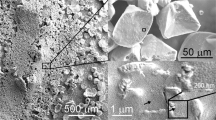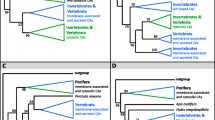Abstract
It has been thought that phosphorus in biominerals made of amorphous calcium carbonate (ACC) might be related to ACC formation, but no such phosphorus-containing compounds have ever been identified. Crustaceans use ACC biominerals in exoskeleton and gastroliths so that they will have easy access to calcium carbonate inside the body before and after molting. We have identified phosphoenolpyruvate and 3-phosphoglycerate, intermediates of the glycolytic pathway, in exoskeleton and gastroliths and found them important for stabilizing ACC.



Similar content being viewed by others
References
Aizenberg, J., Lambert, G., Weiner, S. & Addadi, L. J. Am. Chem. Soc. 124, 32–39 (2002).
Belcher, A.M. et al. Nature 381, 56–58 (1996).
Falini, G., Albeck, S., Weiner, S. & Addadi, L. Science 271, 67–69 (1996).
Kato, T., Sugawara, A. & Hosoda, N. Adv. Mater. 14, 869–877 (2002).
Luquet, G. & Marin, F. C. R. Palevol 3, 515–534 (2004).
Weiner, S. Am. Zool. 24, 945–951 (1984).
Meldrum, F.C. & Cölfen, H. Chem. Rev. 108, 4332–4432 (2008).
Nudelman, F. et al. Nat. Mater. 9, 1004–1009 (2010).
Bentov, S., Weil, S., Glazer, L., Sagi, A. & Berman, A. J. Struct. Biol. 171, 207–215 (2010).
Inoue, H., Ozaki, N. & Nagasawa, H. Biosci. Biotechnol. Biochem. 65, 1840–1848 (2001).
Shechter, A. et al. Proc. Natl. Acad. Sci. USA 105, 7129–7134 (2008).
Tsutsui, N., Ishii, K., Takagi, Y., Watanabe, T. & Nagasawa, H. Zoolog. Sci. 16, 619–628 (1999).
Addadi, L., Raz, S. & Weiner, S. Adv. Mater. 15, 959–970 (2003).
Brečvić, L. & Nielsen, A.E. J. Cryst. Growth 98, 504–510 (1989).
Faatz, M., Gröhn, F. & Wegner, G. Adv. Mater. 16, 996–1000 (2004).
Koga, N., Nakagoe, Y. & Tanaka, H. Thermochim. Acta 318, 239–244 (1998).
Loste, E. & Meldrum, C. Chem. Commun. (Camb.) 901–902 (2001).
House, W.A. J. Colloid Interface Sci. 119, 505–511 (1987).
Sawada, K., Abdel-Aal, N., Sekino, H. & Satoh, K. Dalton Trans. 3, 342–347 (2003).
Hikida, T., Nagasawa, H. & Kogure, T. in Biomineralization (BIOM2001) (eds. Kobayashi, I. & Ozawa, H.) 81–84 (Tokai University Press, Kanagawa, 2003).
Levi-Kalisman, Y., Raz, S., Weiner, S., Addadi, L. & Sagi, I. Adv. Funct. Mater. 12, 43–48 (2002).
Raz, S., Testeniere, O., Hecker, A., Weiner, S. & Luquet, G. Biol. Bull. 203, 269–274 (2002).
Pouget, E.M. et al. Science 323, 1455–1458 (2009).
Suzuki, M. et al. Science 325, 1388–1390 (2009).
Tohse, H. et al. Cryst. Growth Des. 9, 4897–4901 (2009).
Acknowledgements
We are grateful to J.J. Hull for critical reading of the manuscript. We also thank Y. Kagayama (Fisheries Station of Yamagata Prefecture, Japan) for supplying us with the mitten crab. This work was supported by Grants-in-Aid for Scientific Research (nos. 17GS0311, 22248037 and 22228006) from the Japan Society for the Promotion of Science.
Author information
Authors and Affiliations
Contributions
A.S. performed the experiments and wrote the manuscript. A.S., S. Nagasaka and H.N. designed the experiments. K.F. assisted in the NMR measurements and spectral analyses. S. Nagata assisted in the MS measurements. I.A., K.S. and T.K. conducted XRD measurements and supervised crystallographic analysis. S.S. and H.N. supervised the whole project.
Corresponding author
Ethics declarations
Competing interests
The authors declare no competing financial interests.
Supplementary information
Supplementary Text and Figures
Supplementary Methods, Supplementary Figures 1–13 and Supplementary Tales 1 & 2 (PDF 5670 kb)
Rights and permissions
About this article
Cite this article
Sato, A., Nagasaka, S., Furihata, K. et al. Glycolytic intermediates induce amorphous calcium carbonate formation in crustaceans. Nat Chem Biol 7, 197–199 (2011). https://doi.org/10.1038/nchembio.532
Received:
Accepted:
Published:
Issue Date:
DOI: https://doi.org/10.1038/nchembio.532
- Springer Nature America, Inc.
This article is cited by
-
A radial distribution of calices in coral skeleton of Pocillopora verrucosa (Ellis and Solander, 1786) against ocean currents
Marine Biology (2021)
-
The search for proteins involved in the formation of crustacean cuticular structures
Hydrobiologia (2018)
-
Identification of Ligament Intra-Crystalline Peptide (LICP) from the Hinge Ligament of the Bivalve, Pinctada Fucata
Marine Biotechnology (2015)
-
Dehydration and crystallization of amorphous calcium carbonate in solution and in air
Nature Communications (2014)
-
Metabolites empowering minerals
Nature Chemical Biology (2011)





